Ever wondered why many consider Kanjeevaram ( aka., Kancheevaram, Kanchipuram) as the queen of Silks?
According to the Geographical Indication Description, India, an original Kanjivaram should be in the lustrous three-ply silk (called murukku pattu), real zari (thread made of gold or silver), with contrast borders (karai) in Korvai (an interlocking weaving technique by hand), and the pallu (thalaippu) in contrast to the body of the sari, joined by a technique called Petni. The Kanchipuram Silk Saree is hand-woven with dyed silk yarn woven from pure mulberry silk, with interleaved designs made with ‘Zari‘ that is made of gold or silver. The silk thread is twisted with silver and then gilded with Gold. Kancheevaram sarees have an enviable reputation for texture, lustre, durability and finish.The saree, as a traditional wear, is unaltered for years, the only change is in the way it is draped from region to region. The discernible features in technique, design, colour and fabric quality that sets the Kanjeevaram apart.
A bit of History :
These sarees are woven in Kanchipuram, a small city close to Chennai, Tamil Nadu. This minuscule town has more than 129 finely crafted temples.
This city was built by the great Pallavas, as a place of intense worship and learning (called ghatiksthalam in the Tamil language). Kanchipuram soon came to be known as the temple city. The Pallavas worshipped Shiva — the simple ascetic God — not known for needing grand ceremonial robes. His simplicity required nothing more than a white cotton veshti as an offering. This veshti was woven by the finest weavers of that land, from the finest cotton that grew in that region.
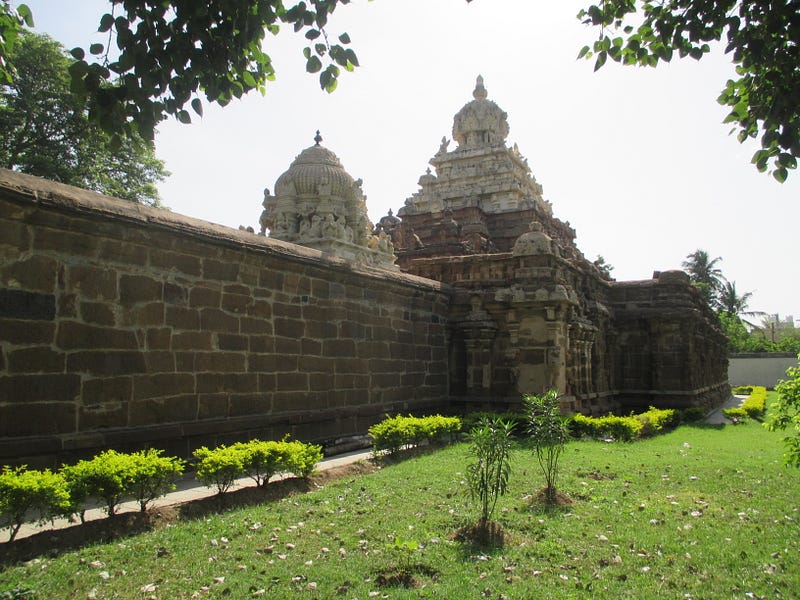
Under the Cholas more temples were built making Kanchipuram a place of religious and spiritual nirvana. Now, the Cholas were Vishnu worshippers. Vishnu, the flamboyant lord, needed, flamboyant robes. The cotton veshti had to undergo a change. First, the only change that was made to it was to attach a brightly coloured silk border embellished with a little gold. This little innovation was done by the expert master weavers of Saurashtra who, after fleeing their own land due Mohammed Ghazni’s invasion, had settled in Kanchipuram because of the huge demand for fine woven fabric. And thus the korvai technique was born. Gradually the cotton veshti was replaced with silk because silk was considered to be pure and hence necessary for worship.
Around the 13th century when the reign of the great Cholas ended, Kanchipuram came under the rule of the Vijayangar kings. It was the great king Krishna Deva Raya who commissioned saree creation for women of the palace to wear for religious ceremonies, weddings and other festivities. The craft actually picked up when the two weaving communities — the Devangas and the Saligars who were reputed for their weaving skills, mass migrated and that’s when Kancheepuram rose to eminence.
Design and Technique :
The most distinguishing feature of a Kanjeevaram Silk saree is the heavily contrasted border and pallu. This contrast defines Kanjeevaram sarees in ways you cannot imagine. The border and pallu are both quite distinctive and are usually heavily embellished with gold or zari depicting traditional motifs like the lotus, parrots or peacocks; highly celebrated but rare motifs. And sometimes simple geometric patterns are used to add a subtle dash of glamour .
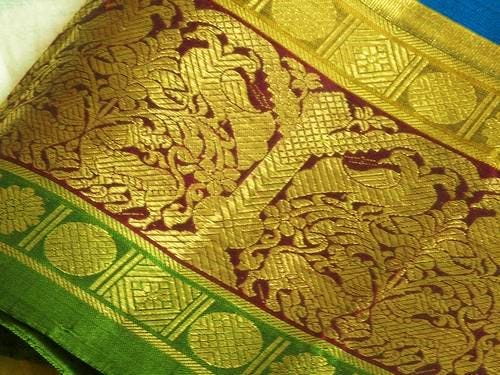
If we delve into the history of the Kanjivaram sari, it becomes apparent that the motifs and designs are closely interrelated to the temples of Kanchipuram. For instance, the lions and yalis (mythical creature), the mango motif from the Ekambareshwarar temple, the classic temple borders from South Indian temples, the rudraksham (holy beads), hamsam (swan) chiselled on the walls and pillars came alive in weave.
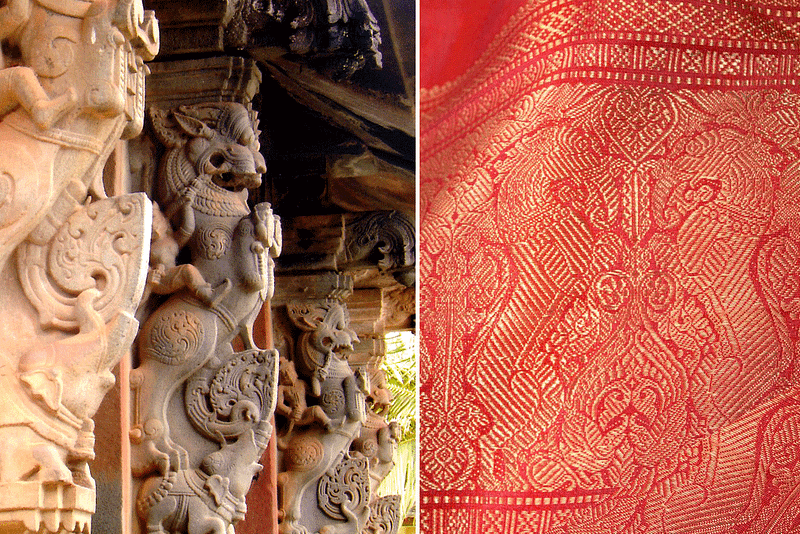
Kanchi’s ancient temples are an eternal font of inspiration. Motifs of flowers, vines, animals, birds and yalis are sourced from the intricate carvings on the pillars, walls and vimanas of the Kailasanatha, Ekambreswara, Varadaraja Perumal and Vaikunta Perumal temples.
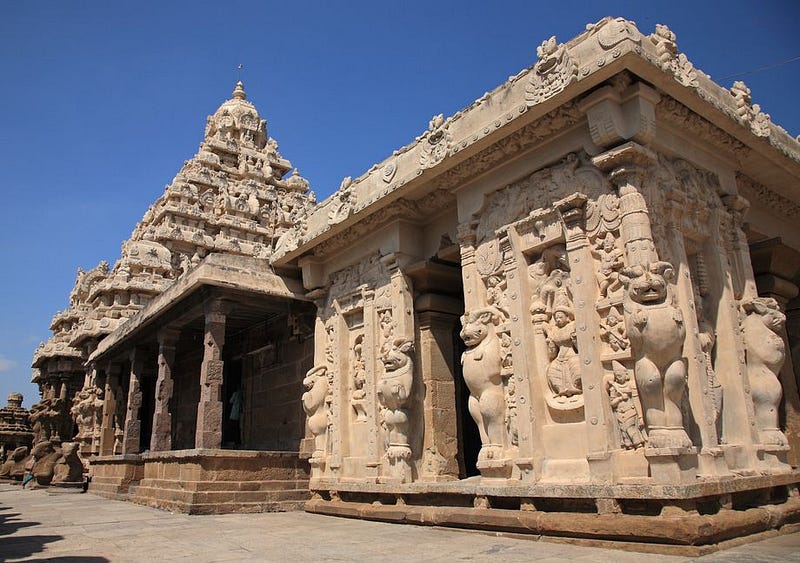
Only in the Kanjivaram, one can find delightful local names for the colours used — vadamalli (bachelor’s button flower), kathiripoo (brinjal flower), elumichai (lemon), aanatha (bliss) blue, elaikai (cardamom), kesari (saffron), naval pazham (java plum), pon vandu (golden beetle), srichurnam (traditional yellow/red line drawn in the middle of a man’s forehead), manthulir (violet with green: a shot colour of tender mango leaves), ennai arakku (a shot colour of violet and brown). These colours, no wonder, have a visual and emotional impact — both on the garment and the person wearing it.
The patterns in the body of the sari may sport buttas or motifs. Malli moggu or the jasmine bud design, coin butta, mango or paisley are amongst the vintage ones. The stripes and checks, the veldhari (representing the spear of Lord Murugan), neli (a type of finger ring), aathi vazhai (horizontal stripes); the different kind of multi-coloured checks, ranging from kottadi or small zari checks, vaira oosi (diamond needles), and muthu kattam to larger checks called papli are very special designs. The geometric precision of a Kanjivaram can be seen in a muppagam or arai pagam sari; muppagam, means three parts and arai pagam means two parts.
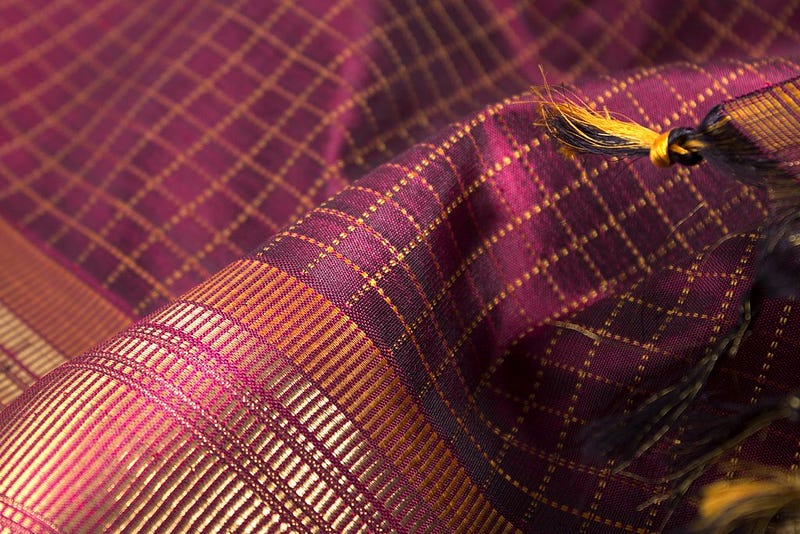
The Kanjeevaram connection to Weddings :
Many communities from Karnataka, even today, insist that the muhurtam sari should carry a rettai pettu (double row) border to signify auspiciousness, with a preference for vermilion, green and yellow hues. For some, the kottadi checks are a must-have. “The muthu kattam checks, resembling evenly spaced pearls, represent the harmonious relationship between the bride and groom. Similarly, the nine-yard koorai pudavai features the arai maadam (half-diamond, wall lamp niche ) pettu which appears uniform in front and reverse, representing the equality of husband and wife.
How to identify a Genuine Kanjeevaram :
The USP of Kanchi handlooms is the korvai technique. It involves the joining of two different colours when the body ( udal) meets the two borders. The second border can be attached only by an extra helper, in a painstaking, labour-intensive process. Kanjeevaram silks are therefore sometimes also referred to as korvai pattu or the saree with ‘attached border’.
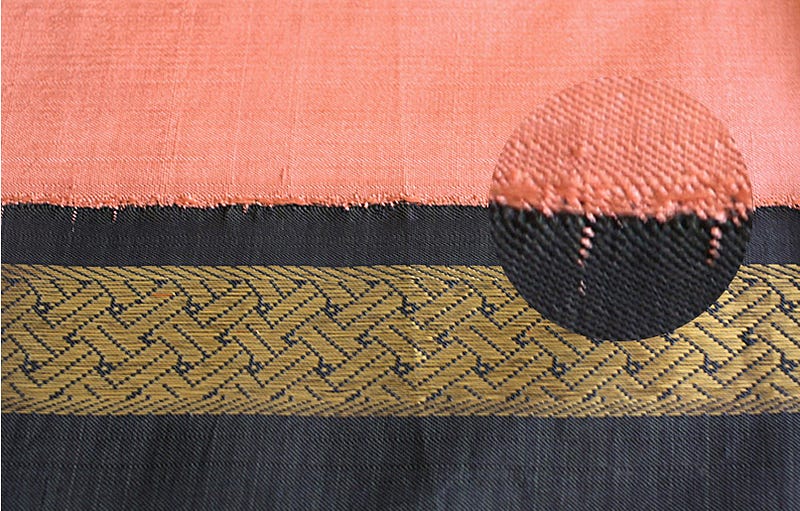
At the point where the udal (Body) is joined with the munthi ( pallu) which carries a contrast colour, a technique called petni is used to create a narrow strip of double thickness, within which warp and weft colours merge to assume a shot hue.
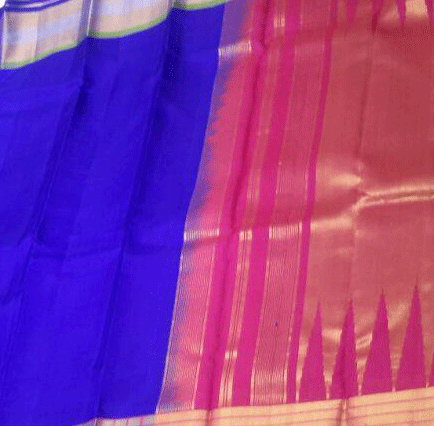
When you think of Kanjeevaram, think of korvai and petni and how it binds generations of cultural evolution that is tightly woven in tradition. These traditional techniques are so deep-rooted in the Kanchipuram culture, that any saree made in Kanchipuram will always have these ‘birthmarks’.
And when you own a Kanjeevaram, you own one of the most enduring legacies of myth, history and culture.
Here is a video of the Making of a Kanjeevaram Saree :
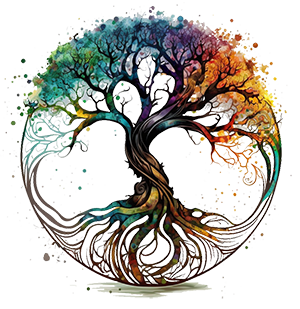
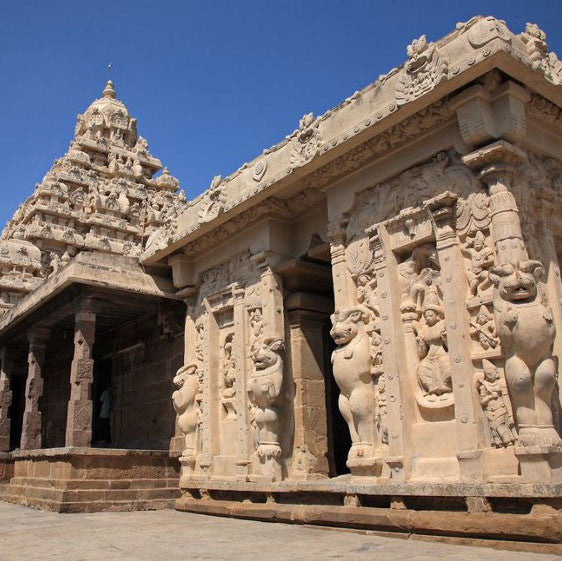
1 comment
A great piece of article about Kanjivaram saree. It is perfect attire for any Indian Bride.